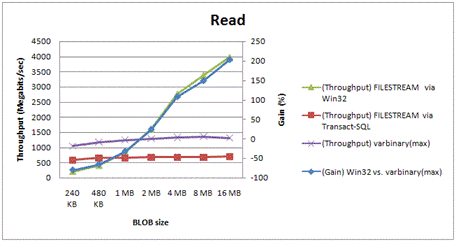Finding #1: Remote Blob Storage RBS is recommended for SharePoint 2010 in conjunction with SQL Server 2008 R2.
Finding #2: I don’t need FILESTREAM when I want use RBS. I can use FILESTREAM in conjunction with RBS though.
|
RBS |
EBS |
|
|
On Microsofts deprecation list |
No |
Yes |
|
BLOB Store scope |
Per Content DB |
Entire farm |
|
BLOB Storage Providers |
More than one |
Just one |
Just for informational purposes, a high level architectural difference between RBS and EBS is that RBS is implemented by SQL Server 2008 R2 and EBS is implemented from a hotfix for MOSS 2007 in SP1 and is part of the SharePoint stack. EBS is still supported but is on the deprecation list.
For RBS, out-of-the-box you get a FILESTREAM provider from Microsoft which allows you to store blobs to disk drives (i.e. c:\myblobstore). It is important to note that SharePoint 2010 doesn’t know (and doesn’t care) that BLOBs are not in the database. That is the provider’s job. Third party vendors will surely release other providers, think storage in the cloud, NAS, other storage mechanisms. So if you need something more than the FILESTREAM provider from Microsoft, you are looking to the third party market.
What is Remote BLOB Storage?
A new feature in SQL Server 2008 R2 is Remote Blob Storage (RBS) which allows admins to setup SQL to save data that would normally go into a BLOB field to be stored outside the database using an RBS provider. This provider could store data on a cheaper disk solution (compared to the expensive disk solutions usually selected for SQL Server), to a SAN or maybe even into the cloud… it really doesn’t matter where. The point is that BLOBs can be kept out of a SQL Server DB.
For SharePoint this has big implications because as a document/attachment centric product, it stores a LOT of data in BLOBs generating large content databases. Before this feature became available in SQL 2008 R2 RBS was pretty much impossible. Some like External Blob Storage (EBS) was just not recommended. SharePoint 2010 when combined with SQL Server 2008 R2 allows admins to do RBS, keeping only metadata in de content DBs and keep the BLOBs out. This is a decisions not to be taken lightly.
First think about backup & restore policy. Additional backups are needed for the remotely stored BLOBs. Those who are looking to gain from RBS are large SharePoint implementations, high investment and usage. Third party vendors of backup software who support RBS therefor have an edge.
When to use Remote BLOB Storage
- RBS is typically recommended in the case where the content databases are 4 gigabytes (4 GB) or larger.
- When the number and the file size get bigger and bigger.
- Intelligent backup and restore mechanisms are in place that support RBS.
When to use FILESTREAM
In SQL Server, BLOBs can be standard varbinary(max) data that stores the data in tables, or FILESTREAM varbinary(max) objects that store the data in the file system. The size and use of the data determines whether you should use database storage or file system storage. If the following conditions are true, you should consider using FILESTREAM:
- Objects that are being stored are, on average, larger than 1 MB.
- Fast read access is important.
- You are developing applications that use a middle tier for application logic.
For smaller objects, storing varbinary(max) BLOBs in the database often provides better streaming performance.
|
Comparison point |
Storage solution |
||
|
File server / file system |
SQL Server (using varbinary(max)) |
FILESTREAM |
|
|
Maximum BLOB size |
NTFS volume size |
2 GB – 1 bytes |
NTFS volume size |
|
Streaming performance of large BLOBs |
Excellent |
Poor |
Excellent |
|
Security |
Manual ACLs |
Integrated |
Integrated + automatic ACLs |
|
Cost per GB |
Low |
High |
Low |
|
Manageability |
Difficult |
Integrated |
Integrated |
|
Integration with structured data |
Difficult |
Data-level consistency |
Data-level consistency |
|
Application development and deployment |
More complex |
More simple |
More simple |
|
Recovery from data fragmentation |
Excellent |
Poor |
Excellent |
|
Performance of frequent small updates |
Excellent |
Moderate |
Poor |
Table 1: Comparison of BLOB Storage Technologies Before SQL Server 2008


Hi,
Nice post. Share Point is truly a life saver but sometimes it has some problems. When BLOBs get overwhelmed in the database, then it gets all messy. Performance drops and I don’t want that to happen. Then I was passing by StorageEdge and checked it out. It is too good with BLOBs. They also have many other excited features to facilitate our needs. You can also check it at http://www.alachisoft.com/storageedge/ebs.html
I recommend it, strongly!
Configure RBS of SQL 2008 with SharePoint 2010 (Remote BLOB Storage) / Thiết đặt thông số RBS của SQL 2008 với SharePoint 2010 http://sharepointtaskmaster.blogspot.com/2011/06/configure-rbs-of-sql-2008-with.html